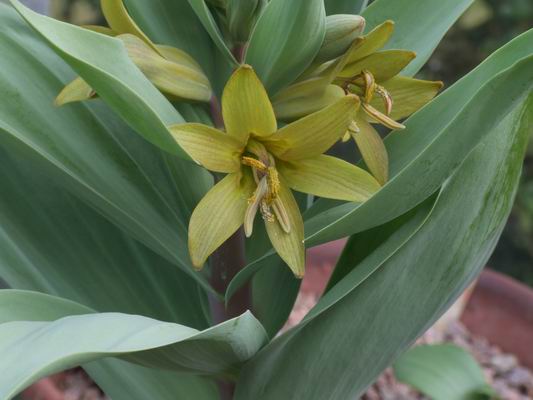|
BULB LOG 12 --- 22nd March 2006

Fritillaria karelinii
I was very interested to see a creamy white form of Fritillaria karelinii 'Pulkhakim' shown by Kath Dryden, at the Frit Group Spring Meeting, on the left. The plant to the right is the first flowering of Fritillaria karelinii I have raised from Gothenburg seed, I was surprised that it was white as I was expecting a pink like the picture below. I am as certain as I can be that Kath's plant and mine are the same with a few variations in the colouration of the throat.

Fritillaria karelinii pink
It is this lovely pink colour that I have become used to under the name of Fritillaria karelinii so I will need to delve a bit further into this lovely species to try and ascertain if this pink one and the very different looking plants above can be the same species.

Fritillaria stenanthera
Also in the Rhinopetalum group is Fritillaria stenanthera which does vary in colour from a pale to a medium shade of pink sometimes with a suggestion of blue through it. All of this group are among the first frits into flower for us and as long as I do the bumble bee's job and transfer the pollen to the stigma with my paint brush I usually get a good set of fertile seeds. One of the main features they all share in common is that they have very deep nectaries which from the outside of the flower looks like a small horn on the shoulder of each petal.

Fritillaria chitralensis
To up date the progress on Fritillaria chitralensis: the two spikes each with six flowers are now looking beautiful and the pollen is flowing freely so I am hoping for a good seed set. I have always been disappointed with the fertility of the seed we have had from our F. chitralensis even though it looks good the germination rate is very poor. I mentioned this during my talk to the Frit Group and was interested to learn that Brian Mathew has had the same experience - we suspect it is because we are all working from a single introduction and maybe the same clone, so that could be the cause of the poor viability of the seed.

Fritillaria sewerzowii
The large flowered form of Fritillaria sewerzowii we got from Janis Ruksans is in flower again; it is a fantastic plant and I am pleased to have got good viable seed from it despite only having the single plant. This is typical of the plant world and why growing bulbs is so interesting when one Frit will produce excellent seed having been fertilised by itself and another, Fritillaria chitralensis, frustratingly has only produced poor seed to date.

Frits in plunge
Despite the low temperatures the fritillarias are pushing up and every day new growth has appeared - this is just a selection of pots in the Gothenburg annex, some flowering sized and others not yet mature. When I travel down to the far south I expect to see their plants are well ahead of ours, sometimes by as much as four weeks, but I noticed no difference on this trip as they have been having some colder weather, more like ours, this winter.

Mist unit
So you can compare the growth of your bulbs with ours I will do a wee tour of some of our plunges and frames to let you see the stage of our plants. This is the mist unit in which I used to propagate all types of plants but it is currently out of service as it seems to have got filled up with pots of bulbs. Seedling pots (7 and 8cm) of crocus, corydalis, fritillaria and narcissus dominate but the eagle eyed among you will spot a few other genera such as cyclamen and tulip.

Narcissus in plunge
The other side of the Gothenburg annex has mostly Narcissus where the winter flowering bulbicodiums are going over only to be replaced by the spring flowering ones.

Narcissus bulbicodium small flower
One interesting form, which is several generations on from seed originally collected in Morocco, has the smallest flowers I have ever seen on a N. bulbicodium - because the stigma sticks out from the corona it would fit into the sub species of nivalis. It is really cute and I could place several of these flowers into one of the corona of a bigger form of bulbicodium.

Outside plunge
In the outside plunge many pots of Narcissus cyclamineus are recovering after being flattened under two feet of snow, their powers of recovery are remarkable.

Narcissus cyclamineus
In another plunge this potful were folded over the wooden baton which is the edge of the frame by the weight of the snow and the only damage was that one flower got knocked off.

Erythronium hendersonii
Just to show how the Spring bulb rush is fast approaching Erythronium hendersonii will soon be in flower. We only need a few days of good sunshine and the temperature to rise a bit and the garden will be full of flowering bulbs.

Eranthis Guinea Gold
Our box of Eranthis Guinea Gold has also recovered from being flattened by the snow and they opened their flowers in today's sunshine.
^ back to the top ^
|

